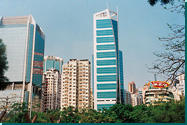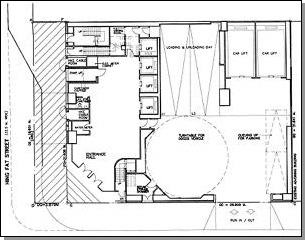| June
2001 |
 |
|
|
88 Hing Fat
Street
Parkside
prominence
Just
east of Causeway Bay's Victoria Park, a new office tower is cutting
a distinctive two-tone form, commanding views of the green open
space and the harbour.
The
88 Hing Fat Street site benefits from a prominent location on the
corner of two busy roads, overlooking Victoria Park and featuring
unobstructed harbour views. In briefing project Architects Andrew
Lee King Fun & Associates Architects, client Chung Shun Land
Investment Co Ltd called for an equally prominent design for the
office tower.
The harbour views over the
Royal Hong Kong Yacht Club moorings offered subtle influence
-- the final tower features a curved, sail-like elevation. With
the concept approved and refined, the striking form was edged with
tubular features in "molten silver" that add tension to
the form. Although the building exterior was designed to create
an impact, the architects were mindful not to take ornamentation
too far, explained architect Christina Lee. "Because the form
itself is so strong, we thought we needn't do too much to add to
the style."
With
an emphasis on form over colour, the curtain wall is kept to bluish
glazing and "molten silver" aluminium cladding. At roof
level, the tubular features extend on angled reinforced concrete
columns.
Lee noted that the curtain
wall and cladding at 88 Hing Fat Street was expected to be more
expensive than systems on similarly sized projects. Regional economic
crisis, however, meant that by the 1998 tender date sub-contractors
and suppliers were offering significantly reduced fees, making the
project less expensive than originally intended.
The curved elevation posed
difficulties in specifying a suitable cleaning system. The roof
features restricted access to a certain extent and the overhang
at lower floors was an issue. Following interviews with gondola
specialists, the architects chose a gondola system from Buildtech
that works like a drawing compass. The platform is jacked up on
the lower curve, placing the cradle towards the building and keeping
it stable. The architects worked with the gondola supplier to help
coordinate placing the system for most efficient maneuverability
on the tight roof space, thereby smoothing the workflow and ensuring
preparation during construction.
Office facilities
The size of the site limited the extent of the outer curve
and called for efficient layouts to meet site constraints and provide
the most pleasant office environment for future tenants. Cantilevered
floor plates are oriented to best admit the views, and adopt an
L-shaped plan fanning out from the building core. Service areas
are housed at the rear corner of the site.
Since inception in mid-1997,
the development has been proposed and designed with an eye toward
IT firms, consultancies and other medium-sized businesses. Though
relatively uncommon at the time, the developers requested raised
flooring and structured broadband cabling to be built in.
The architects sought a raised
flooring system limited to a 150-mm height, including access panels.
The relatively low height for the system takes into account the
3.5-metre floor-to-ceiling measurements at 88 Hing Fat Street, and
a desire not to increase the headroom and construction costs that
would correspond. An existing system was modified to form a simple
system of pedestals without additional support or channels.
Site supervision
Complexity of the design and site saw the architects take a
supervisory role to help guide the project through the construction
process. Though the design concept is simple, the curtain wall design
created certain challenges for the contractor.
The segmented curve of straight
lines meant that certain beams would not be vertical. Similarly,
the different floor sizes to meet the curve meant that re-using
formwork was no simple matter. The architects assumed a coordination
role to ensure precise adherence to plans in realising the building
form.
Similarly, the interiors needed
special attention, since the curve did not allow for standard wall
units, and required soffits and seals of varying sizes from floor
to floor. Interior finishing was carried out with on-site fabrication,
Lee said, and a mock-up was provided for reference.
In addition to the building
form, the architects and client encountered a challenge during the
government submission. A portion of land for road widening was exchanged
in return for a higher plot ratio. The road works, which had to
contend with buried utilities during construction, were required
before the building's Occupation Permit was issued in January this
year.
architect Andrew Lee King Fun & Associates Architects
developer The Chung Shun Land Investment Co Ltd
building services MECS Consulting Engineers
structural engineers HK Cheng & Partners
main contractor Wing Sum Construction & Engineering Co Ltd
|

